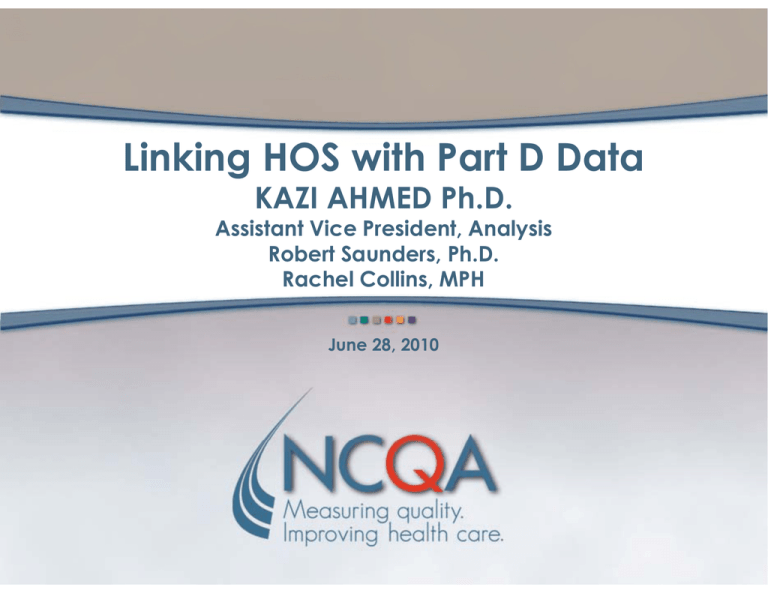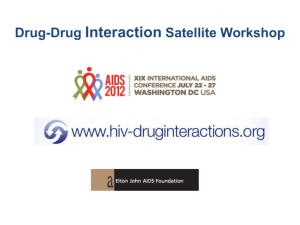Linking HOS with Part D Data KAZI AHMED Ph.D.
advertisement

Linking HOS with Part D Data KAZI AHMED Ph.D. Assistant Vice President President, Analysis Anal sis Robert Saunders, Ph.D. Rachel Collins, MPH June 28, 2010 NCQA: A BRIEF INTRODUCTION • Private, independent non-profit health care quality lit oversight i ht organization i ti founded in 1990 • Committed to measurement, transparency and accountability • Unite diverse groups around common goal: improving health care quality 2 NCQA MILESTONES • 70% of insured Americans are in an NCQA Accredited health plan • 109 million Americans are in an NCQA Accredited i health plan • 41% of all health plans in the United States are NCQA Accredited HEDIS® is a registered trademark of NCQA. NCQA 3 NCQA MILESTONES, CONT’D • 38 states and the Federal government rely on NCQA Accreditation and HEDIS • Over 12,000 physicians recognized through NCQA’s Recognition Programs – NCQA’s Recognition Programs form the basis of quality improvement programs nationwide 4 What is HEDIS®? • Healthcare Effectiveness Data and Information Set (HEDIS) comprises of 76 process, outcomes and structure measures grouped into 8 domain areas (effectiveness of care, care access/availability of care, satisfaction with the experience of care, use of services, cost of care, health plan descriptive information, health plan stability, and informed health care choices) • Member level data collected for some measures – Consumer Assessment of Healthcare Providers & Systems (CAHPS®) survey and Health Outcomes Survey (HOS) • Plan level data collected for all other measures – Administration (claims) or medical records data sources • For most reporting all data are aggregated at plan level. The format of the file is one record per plan per measure. • HEDIS measures are used by Commercial, Medicare, and Medicaid plans alike 5 Medicare Health Outcomes Survey (HOS) •HOS collects longitudinal, functional status survey data for Medicare beneficiaries enrolled in Medicare Advantage plans. –A Assess a Medicare M di Advantage Ad t Organization’s O i ti ’ (MAO) ability to maintain or improve the physical and mental health of its Medicare members over time. • Project began in 1997 as the Health of Seniors Survey • Administered to a random sample of members from each Medicare Managed Care Organization (MAO) • Cohort surveyed and then re-surveyed re surveyed 2 years later 6 HOS Reporting Requirements • Contracts in effect for at least 1 year with a minimum i i enrollment ll t off 500 members b • Types of Plans: – All Coordinated Care Plans: Medicare Advantage Organizations (MAOs) including local and regional Preferred Provider Organizations (PPOs) (PPOs), and – Continuing cost contracts that held §1876 risk and cost contracts – Private Fee-for-Service Plans and Medical Savings Accounts (voluntarily) 7 HOS Components • Total number of questions in the HOS 2.0 Survey = 64 • Veterans RAND 12 Item Health Survey (VR-12) (VR 12) as core (adapted from Veterans RAND 36-item (VR-36) Health Survey) • Additional items: – Information for case case-mix mix adjustment – Information required by the 1997 Balanced Budget Act – Select HEDIS Effectiveness of Care measures • Management of Urinary Incontinence in Older Adults (MUI), Physical Activity in Older Adults (PAO), Fall Risk Management (FRM), and Osteoporosis Testing in Older Women (OTO) 8 Health Outcomes Survey (HOS) • Two summary scores: – VR 12 items form 8 scales (physical functioning (pf) (pf), rolephysical (rp), bodily pain (bp), general health (gh), vitality (vt), social functioning (sf), role-emotional (re), mental health (mh)) • 8 scales summarized into 2 measures – Physical component summary score (PCS) – Mental M t l componentt summary score (MCS) • Normed for U.S. population using normative values so that 50 represents the national average for summary scores and +/- 10 represents 1 standard d d deviation d i i above b or below b l the h mean • 2-year change scores: – Beneficiaries’ physical and mental health status are categorized as better, the same or worse than expected. • Case mix adjusted 9 Why Link Part D Events with HOS • Unique opportunity to directly examine – drug benefits and usage – Association between drug utilization and patient specific physical and mental health outcomes • Some research questions: q – What % of the HOS beneficiaries used Part D? – How do beneficiaries with or without PDE compare along demographic g p characteristics,, health outcomes,, plans, p , and geographical location? – What is the average number of prescription drugs used? What is the average number of refills? – What is the average patient pay amount and how do they vary across demographic groups, health outcomes, plans, and regions? – What Wh t classes l off d drugs are mostt commonly l used d and d how h do d they vary across demographics, health outcomes, plans, and regions/states? 10 PART D DATA (13 variables) ID Dates Drug Dispensed Cost Dosage Part D Event id RX service date (date prescription filled) Quantity dispensed (number of units units-grams, grams, milliliters, etc. dispensed in the current drug) patient pay amount (non-reimbursable (non reimbursable $ beneficiary paid), dosage form code (tablet, capsule, or liquid) beneficiary identifier days supply (number of y supply pp y of day’s medication) gross drug cost ( (composite p of ingredient g cost paid, dispensing fee paid, and total amount attributed to sales tax) dosage form code description p ((extended text of dosage form code) product service id (NDC p drug) g) of dispensed brand name (name that appears pp on p package) g ) generic name (drug ingredient name adopted by USAN/chemical name when USAN not available drug strength (description of drug potency in units of grams, milligrams, %, other) 11 Description of PDE File • Part D Drug File of Prescription Drug Events – CMS used the HOS Sample Frame to identify all PDEs generated by members using all related identification numbers – One record-per-PDE-per-person p p p (i.e., multiple prescriptions for multiple drugs) – ≈ 11m records generated by members in the sample frame 12 Description of HOS File • HOS Survey Database (People) – – – – One record-per-person 188k members in the sample p frame 118k members completed ≥ 50% of survey ≈ 60% response rate (for purposes of this analysis) 13 Linking the Files • 2006-2008 Medicare Cohort 9 HOS data (baseline and follow-up) linked with 2006-2007 Medicare Part D Prescription p Drug g Event ((PDE)) data • Link records based on unique beneficiary ID (Health Insurance Claims (HIC) number and Social Security Number (SSN)) • Person-matching: Sample Frame – ≈ 168k people generated the 11m PDEs (≈ 20k did not have any PDEs) – Person-level match rate of 89% • Person-matching: Person matching: HOS Baseline Respondents – ≈ 118k people had a usable baseline survey – ≈ 100k people with baseline and PDE – Person-level match rate of 85% • Initial Inference: about 85% of HOS respondents use Part D for prescription i ti drugs d 14 Linking Results • • • • • • HOS n=118,279 (respondents with complete or partially complete baseline survey) Match rate=85.3% (n=100,873) linked to Part D Event data set – Possible reasons for non non-matching matching PDEs • Respondent was enrolled in Part D but did not use the benefit in 2006 and 2007 • The respondent was in a MA-only plan (not a MA-PD) and thus not enrolled in Part D 10,309,177 drug event records representing 3421 unique 9-digit NDC codes Frequency of prescription drugs dispensed – – – Mean number of unique 9-digit drugs for each MA enrollees= 4.3 (Min=1 and Max=132) Mean number of times a MA enrollee has a prescription for each of the 9-digit drug numbers= 14.8 (Min=1 and Max =177) Mean number of refills=5.78 (Min=1 and Max=131) – Demographics Characteristics of non-matched versus matched • • • • • Women more likely to be enrolled in Part D than men (87%vs 82%) Less than or equal to 65 most likely to use Part D than those over 65 (92% vs 84-86%) Asian and Hispanic population utilization rate (92 vs 95%) African American and American Indian population utilization rate (88% each) White population utilization rate (85%) Geographical characteristics • Utilization rate among respondents in Mid-Atlantic Mid Atlantic and East North Central (81 and 75% respectively) • Utilization rate among respondents in the South Atlantic, North East and US Territories (94, 91 and 95% respectively) 15 Part D DPE Data Limitation • Approximately 11% of HOS beneficiaries did nott h have matching t hi PDEs PDE • May have used other drug sources • Non-whites higher usage rate-why? • Do whites have alternatives to Part D – Potential source of bias in estimates • No Standardized Drug Classification information available • We used d VA drug d classification l ifi ti –only l 60% off our drugs matched VA classification 16 Thank You! 17

